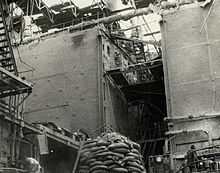| Bombing of Shanghai | |||||||
|---|---|---|---|---|---|---|---|
| Part of Chinese civil war | |||||||
 Zhabei Water and Power Plant after the bombing of 6 February 1950 | |||||||
| |||||||
| Belligerents | |||||||
|
| ||||||
| Commanders and leaders | |||||||
|
|
| ||||||
The Bombing of Shanghai was a series of air raids conducted by the Republic of China (ROC) forces on Shanghai, which was under the control of the People's Republic of China (PRC), from 1949 to 1953. After the conclusion of the Shanghai Campaign in May 1949, the People's Liberation Army (PLA) of Chinese Communist Party (CCP) took control of the city. Despite their retreat to Taiwan, the ROC Air Force (ROCAF) continued to launch bombings on Shanghai, leading to severe civilian casualties and the disruption of industrial activities.
The most devastating incident during this bombing campaign took place on 6 February 1950, when the ROC Air Force dispatched 14 bombers and 3 fighter planes to carry out an attack on Shanghai. Over the course of an hour and a half, they dropped 60 to 70 bombs weighing 500 pounds each, destroying over 2,000 buildings and causing over 1,400 civilian casualties.[2] This led to the suspension of operations at several factories and the destruction of key infrastructure, including the Yangshupu Power Plant and Shanghai Tramways.[3] After the bombing, the CCP's intelligence discovered and dismantled a ROC spy base. On the afternoon of 7 February, Luo Bingqian, the head of the Taiwanese Intelligence Bureau in Shanghai, was executed by the Shanghai Public Security Bureau.
The air raids on 6 February 1950 led to the intervention of the Soviet Air Forces, which additionally provided over a hundred aircraft of various types and several anti-aircraft guns, which succeeded in downing multiple ROC aircraft. The ROC government decided to prioritise the security of Taiwan and withdrew its forces from the Zhoushan Archipelago, losing its base for bombing operations against Shanghai. This marked the end of large-scale air raids and skirmishes over the city. After the conflict, the Soviets transferred their aircraft and equipment to the Chinese, allowing the PLA to establish its first air defence force.
- ^ "空军代表会开幕,总裁亲临勖勉". Central Daily News. 1950-02-07. p. 4.
- ^ 《关于“二·六”轰炸前后本市人防工作情况资料》,1962年,上海市人防办档案
- ^ (in Chinese)"揭秘:建国初期 大上海上空反轰炸防御保卫战". 国际在线. 2011-12-06. Archived from the original on 2016-03-04. Retrieved 2013-06-19.